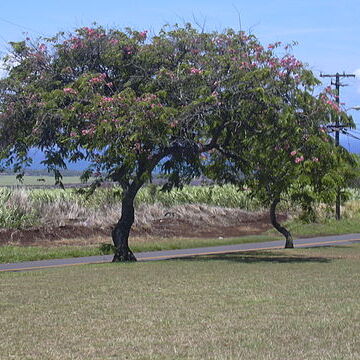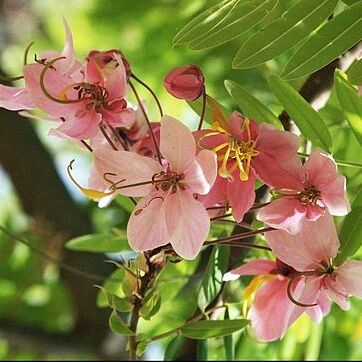Trees, shrubs or herbs, or sometimes vine-like. Leaves pinnate, 2-to many-foliolate or occasionally aphyllous, often with petiolar or rachial glands; leaflets entire, often inequilateral. Inflorescence bracteate, axillary or terminal, racemose or paniculate or the flowers rarely subsolitary. Flowers usually yellow, conspicuous; calyx with a disc-like base and 5 usually imbricate sepals; petals 5, distinct, ex-panded, often unequal; stamens 10-4, the 3 uppermost usually rudimentary or lacking, the 4 median similar, usually intermediate in size, often conspicuously rostrate; the 3 lowermost similar or dissimilar, rarely lacking, variously modified but usually rostrate, usually larger than the median stamens; anthers dehiscent by terminal or basal pores or sometimes (in addition) lateral slits, basifixed and erect; ovary sessile or stipitate, several-to many-ovulate. Legume dehiscent or sometimes indehiscent, terete or more often compressed or flattened, the seeds often horizontal, the funicle filiform to very short.
Small, unarmed trees or tall shrubs, glabrous or pubescent. Leaves alternate, paripinnate, lacking glands; stipules acicular, usually caducous; leaflets in 3-25 pairs. Inflorescence terminal, racemose, bracteate and bracteolate. Flowers slightly zygomorphic. Sepals 5, subequal, obovate, green or yellowish. Petals 5, yellow or rarely pink or reddish. Stamens and staminodes 10, free; filaments unequal; 3 adaxial ones almost obsolete; 4 median ones longer; 3 abaxial ones greatly elongate, sigmoidally curved, often nodulate medially; anthers versatile, never beaked; 3 adaxial ones staminodal; 4 median ones fertile and basally porose; 3 abaxial ones fertile, basally and apically porose. Ovary curved, longer than petals; style short; stigma terminal. Pod cylindric, compressed-cylindric or compressed, woody, indehiscent; septae transverse between the seeds. Seed funicles filiform.
Trees or large shrubs. Leaves spirally arranged, often distichous, paripinnate; extra-floral nectaries not present. Inflorescence racemose, terminal on main shoots or on short side shoots; pedicels with 2 bracteoles at or shortly above the base. Hypanthium variable. Calyx 5-merous, sepals reflexed at anthesis. Corolla zygomorphic, 5-merous. Androecium zygomorphic, 10-merous, filaments of 3 abaxial, antesepalous stamens sigmoid-ally curved, usually longer than their anthers, dehiscent by slits; the remaining 7 filaments straight and short with anthers mostly dehiscing by basal pores. Pods elongate, cylindric or compressed, indehiscent. Seeds many, 1-or 2-seriate; funicle filiform.
Trees or large shrubs. Leaves spirally arranged, often distichous, abruptly pinnate; rachis and petioles without glands; leaflets opposite, without stipels. Flowers in terminal panicles on main shoots or racemes on short side shoots; pedicels with 2 bracteoles at or shortly above base. Calyx 5-merous; sepals reflexed at anthesis. Corolla zygomorphic; petals 5. Stamens 10; filaments of 3 abaxial antesepalous stamens sigmoidally curved, usually longer than their anthers, dehiscent by slits; remaining 7 filaments straight and short, with anthers mostly dehiscent by basal pores. Legume elongate, cylindric or compressed, indehiscent. Seeds numerous, 1-or 2-seriate; funicle filiform.
Stamens 10, the three anticous ones long, sigmoidally curved at the base, often swollen near the middle; anthers dorsifixed, dehiscing by basal slits and often also by terminal pores.
Ovary stipitate, curved; ovules numerous; stigma terminal or subterminal, often recessed forming a stigmatic chamber.
Inflorescence simply racemose, or paniculate; bracts and bracteoles small, caducous or subpersistent.
Seeds numerous, without an areole, free in chambers within the fruit or surrounded by pulp.
Leaves paripinnate; leaflets opposite or subopposite; stipules small, usually caducous.
Petals 5, large, yellow or white (pink in introduced species).
Pods cylindrical, tardily dehiscent or indehiscent.
Hypanthium small, obconical, infilled.
Trees or occasionally shrubs, unarmed.
Calyx lobes 5, equal, imbricate.


